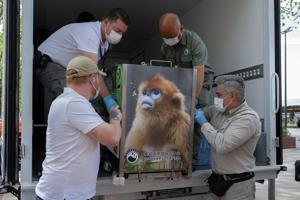
News
November 03, 2025
China's rare golden monkeys debut at European zoos, possible successors to panda diplomacy
Monkeys have deep roots in Chinese art and culture, appearing in countless paintings and as characters in classic literature.
**China's rare golden monkeys debut at European zoos, possible successors to panda diplomacy**
Golden snub-nosed monkeys, a rare and enchanting primate species native to China, are making their debut at several European zoos, sparking excitement among wildlife enthusiasts and raising questions about a potential new era of cultural exchange. These striking creatures, with their distinctive blue faces and golden fur, are deeply embedded in Chinese culture, appearing in art and literature for centuries.
Their arrival in Europe is seen by some as a potential successor to the long-standing tradition of "panda diplomacy," where China has historically loaned giant pandas to zoos around the world as a gesture of goodwill and international cooperation. While pandas remain a beloved symbol, the introduction of golden snub-nosed monkeys offers a fresh perspective on China’s rich biodiversity and cultural heritage.
The monkeys’ presence in European zoos provides a unique opportunity for conservation education. These animals are classified as endangered, facing threats from habitat loss and hunting in their native mountainous regions of central and southwestern China. By showcasing these primates, zoos hope to raise awareness about their plight and inspire support for conservation efforts in China.
Golden snub-nosed monkeys are more than just aesthetically pleasing; they hold significant cultural weight within China. They frequently appear in traditional paintings, symbolizing good fortune and longevity. Furthermore, the iconic character Sun Wukong, the Monkey King from the classic Chinese novel "Journey to the West," is a powerful and beloved figure, further cementing the monkey's place in the national consciousness.
The European zoos housing these monkeys are carefully selected and equipped to provide the specialized care these animals require. The zoos are working closely with Chinese experts to ensure the monkeys’ well-being and to replicate their natural habitat as closely as possible. The hope is that these monkeys will thrive in their new homes and potentially contribute to the species' long-term survival through breeding programs.
The arrival of these magnificent primates marks a significant moment in international conservation and cultural exchange. Whether they will truly become the next symbol of China’s diplomatic outreach remains to be seen, but their presence in Europe undoubtedly offers a captivating glimpse into the wonders of Chinese biodiversity and the rich cultural narratives associated with these remarkable animals.
Golden snub-nosed monkeys, a rare and enchanting primate species native to China, are making their debut at several European zoos, sparking excitement among wildlife enthusiasts and raising questions about a potential new era of cultural exchange. These striking creatures, with their distinctive blue faces and golden fur, are deeply embedded in Chinese culture, appearing in art and literature for centuries.
Their arrival in Europe is seen by some as a potential successor to the long-standing tradition of "panda diplomacy," where China has historically loaned giant pandas to zoos around the world as a gesture of goodwill and international cooperation. While pandas remain a beloved symbol, the introduction of golden snub-nosed monkeys offers a fresh perspective on China’s rich biodiversity and cultural heritage.
The monkeys’ presence in European zoos provides a unique opportunity for conservation education. These animals are classified as endangered, facing threats from habitat loss and hunting in their native mountainous regions of central and southwestern China. By showcasing these primates, zoos hope to raise awareness about their plight and inspire support for conservation efforts in China.
Golden snub-nosed monkeys are more than just aesthetically pleasing; they hold significant cultural weight within China. They frequently appear in traditional paintings, symbolizing good fortune and longevity. Furthermore, the iconic character Sun Wukong, the Monkey King from the classic Chinese novel "Journey to the West," is a powerful and beloved figure, further cementing the monkey's place in the national consciousness.
The European zoos housing these monkeys are carefully selected and equipped to provide the specialized care these animals require. The zoos are working closely with Chinese experts to ensure the monkeys’ well-being and to replicate their natural habitat as closely as possible. The hope is that these monkeys will thrive in their new homes and potentially contribute to the species' long-term survival through breeding programs.
The arrival of these magnificent primates marks a significant moment in international conservation and cultural exchange. Whether they will truly become the next symbol of China’s diplomatic outreach remains to be seen, but their presence in Europe undoubtedly offers a captivating glimpse into the wonders of Chinese biodiversity and the rich cultural narratives associated with these remarkable animals.
Category:
Entertainment